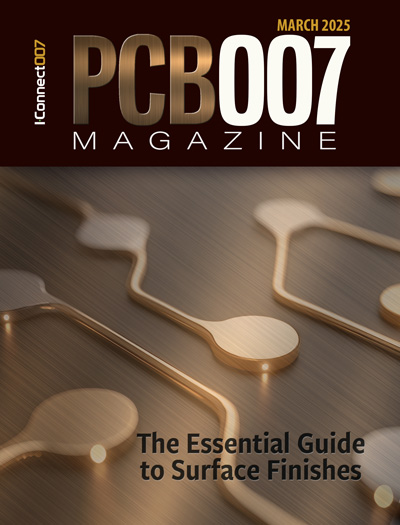-

- News
- Books
Featured Books
- pcb007 Magazine
Latest Issues
Current Issue
In Pursuit of Perfection: Defect Reduction
For bare PCB board fabrication, defect reduction is a critical aspect of a company's bottom line profitability. In this issue, we examine how imaging, etching, and plating processes can provide information and insight into reducing defects and increasing yields.

Voices of the Industry
We take the pulse of the PCB industry by sharing insights from leading fabricators and suppliers in this month's issue. We've gathered their thoughts on the new U.S. administration, spending, the war in Ukraine, and their most pressing needs. It’s an eye-opening and enlightening look behind the curtain.

The Essential Guide to Surface Finishes
We go back to basics this month with a recount of a little history, and look forward to addressing the many challenges that high density, high frequency, adhesion, SI, and corrosion concerns for harsh environments bring to the fore. We compare and contrast surface finishes by type and application, take a hard look at the many iterations of gold plating, and address palladium as a surface finish.
- Articles
- Columns
Search Console
- Links
- Media kit
||| MENU - pcb007 Magazine
Microtek Laboratories China Completes First IPC-4101D Validation Services Test Program Worldwide
May 17, 2017 | Microtek Laboratories ChinaEstimated reading time: 1 minute
Microtek Laboratories China has completed the first qualification test program for IPC-4101D Validation Services. The Qualification Testing for IPC-4101 Validation Services must be conducted at an IPC-approved independent test lab. The products tested were the first copper-clad laminate materials worldwide to be QPL-certified under the IPC Validation services. The testing protocol followed the requirements of IPC-4101D for qualification:
3.4 Qualification Testing: Laminate and prepreg base materials furnished under this specification shall be qualified as described in Table 3-1 for laminates and Table 3-2 for prepregs. The supplier shall retain on file, supporting data that the materials meet the requirements of this specification using the test methods described herein. Qualification testing shall be performed to demonstrate the supplier’s ability to meet all of the requirements of each applicable specification sheet for each base material.
The 23 qualification tests for each base material included performance characteristics such as peel strength after various conditioning steps, electrical performance, Dk / Df, physical properties, dimensional stability, moisture absorption, chemical resistance, flammability, Z-axis expansion, T260, T288, T300, glass transition temperature (Tg) and decomposition temperature (Td). The minimum performance requirements were based on the IPC-4101D specification sheets 102, 126 and 130.
According to Doug Sober, Director of International Sales & Marketing, "This is the first of many qualification projects for IPC-4101 as high-end, base material suppliers try to separate their products from the rest of the commodity producers."
About Microtek Laboratories China
Microtek Laboratories China is a leading third-party testing agency, serving electronic and polymeric material manufacturing industry world-wide. It is operated in accordance with the ISO/IEC17025: 2005 management system, accredited by CNAS and CMA, and capable of issuing internationally recognized test and analysis reports. The lab is a certificated UL-EA lab* for PCB/CCL/ink products in China and is a CQC licensed lab for "Non-metal materials" including printed circuit boards (PCB), copper-clad laminates (CCL) and plastics. We are also the product service center for CPCA, an authorized training center for IPC-6012, IPC-A-610 and IPC-A-600, as well as a IPC Validation Services Certified Test Laboratory for IPC-6012C and IPC-4101D. In addition, Microtek Laboratories China has the capability of temperature and humidity calibration as recognized by CNAS. For more information, contact DougSober@TheTestLab.cn.
Suggested Items
Preventing Surface Prep Defects and Ensuring Reliability
06/10/2025 | Marcy LaRont, PCB007 MagazineIn printed circuit board (PCB) fabrication, surface preparation is a critical process that ensures strong adhesion, reliable plating, and long-term product performance. Without proper surface treatment, manufacturers may encounter defects such as delamination, poor solder mask adhesion, and plating failures. This article examines key surface preparation techniques, common defects resulting from improper processes, and real-world case studies that illustrate best practices.
RF PCB Design Tips and Tricks
05/08/2025 | Cherie Litson, EPTAC MIT CID/CID+There are many great books, videos, and information online about designing PCBs for RF circuits. A few of my favorite RF sources are Hans Rosenberg, Stephen Chavez, and Rick Hartley, but there are many more. These PCB design engineers have a very good perspective on what it takes to take an RF design from schematic concept to PCB layout.
Trouble in Your Tank: Causes of Plating Voids, Pre-electroless Copper
05/09/2025 | Michael Carano -- Column: Trouble in Your TankIn the business of printed circuit fabrication, yield-reducing and costly defects can easily catch even the most seasoned engineers and production personnel off guard. In this month’s column, I’ll investigate copper plating voids with their genesis in the pre-plating process steps.
Elephantech: For a Greener Tomorrow
04/16/2025 | Marcy LaRont, PCB007 MagazineNobuhiko Okamoto is the global sales and marketing manager for Elephantech Inc., a Japanese startup with a vision to make electronics more sustainable. The company is developing a metal inkjet technology that can print directly on the substrate and then give it a copper thickness by plating. In this interview, he discusses this novel technology's environmental advantages, as well as its potential benefits for the PCB manufacturing and semiconductor packaging segments.
Trouble in Your Tank: Organic Addition Agents in Electrolytic Copper Plating
04/15/2025 | Michael Carano -- Column: Trouble in Your TankThere are numerous factors at play in the science of electroplating or, as most often called, electrolytic plating. One critical element is the use of organic addition agents and their role in copper plating. The function and use of these chemical compounds will be explored in more detail.


